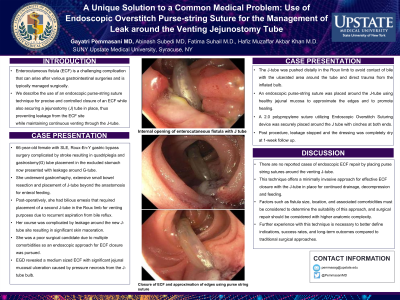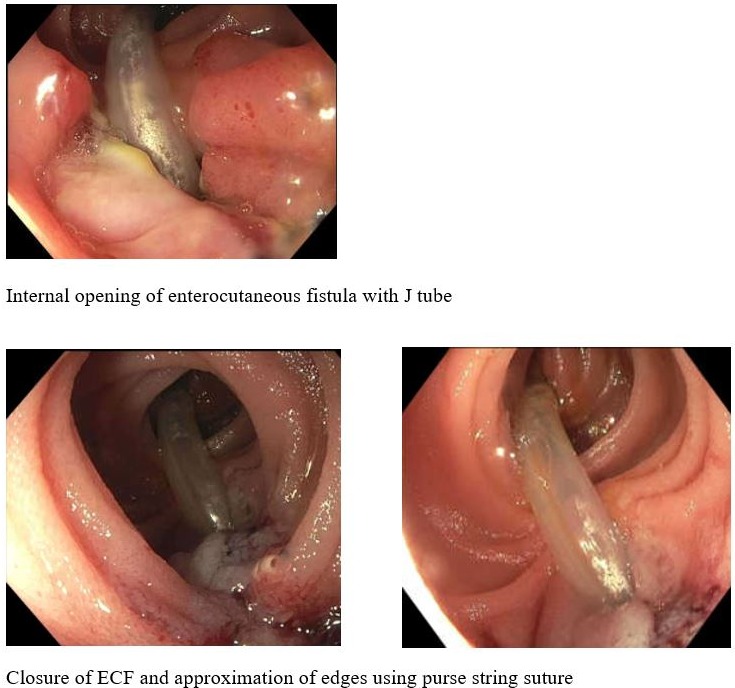Monday Poster Session
Category: Interventional Endoscopy
P2309 - A Unique Solution to a Common Medical Problem: Use of Endoscopic Overstitch Purse-String Suture for the Management of Leak Around the Venting Jejunostomy Tube
Monday, October 23, 2023
10:30 AM - 4:15 PM PT
Location: Exhibit Hall

- GP
Gayatri Pemmasani, MD
SUNY Upstate
Syracuse, NY
Presenting Author(s)
Gayatri Pemmasani, MD1, Abinash Subedi, MBBS2, John Joyce, MBBS3, Fatima Suhail, MD1, Hafiz M. Khan, MD2
1SUNY Upstate, Syracuse, NY; 2SUNY Upstate Medical University, Syracuse, NY; 3SUNY Upstate University Hospital, Syracuse, NY
Introduction: Enterocutaneous fistula (ECF) is a challenging complication that can arise after various gastrointestinal surgeries and is typically managed surgically. We describe the use of an endoscopic purse-string suture technique for precise and controlled closure of an ECF while also securing a jejunostomy (J) tube in place, thus preventing leakage from the ECF site while maintaining continuous venting through the J-tube.
Case Description/Methods: 66-year-old female with SLE, Roux-En-Y gastric bypass surgery complicated by stroke resulting in quadriplegia and gastrostomy(G) tube placement in the excluded stomach now presented with leakage around G-tube.
She underwent gastrorrhaphy, extensive small bowel resection and placement of J-tube beyond the jejuno-jejunal anastomosis for enteral feeding. Post-operatively, she had bilious emesis that required placement of a second J-tube in the Roux limb for venting purposes due to recurrent aspiration from bile reflux. Her course was complicated by leakage around the new J-tube site resulting in significant skin maceration. She was a poor surgical candidate due to multiple comorbidities so an endoscopic approach for ECF closure was pursued. EGD revealed a medium sized ECF (Figure) with significant jejunal mucosal ulceration caused by pressure necrosis from the J-tube bulb. The J-tube was pushed distally in the Roux limb to avoid contact of bile with the ulcerated area around the tube and direct trauma from the inflated bulb. An endoscopic purse-string suture was placed around the J-tube using healthy jejunal mucosa to approximate the edges and to promote healing (Figure). A 2.0 polypropylene suture utilizing Endoscopic Overstitch Suturing device was securely placed around the J tube with cinches at both ends. Post procedure, leakage stopped and the dressing was completely dry at 1-week follow up.
Discussion: There are no reported cases of endoscopic ECF repair by placing purse string sutures around the venting J-tube. This technique offers a minimally invasive approach for effective ECF closure with the J-tube in place for continued drainage, decompression and feeding. Factors such as fistula size, location, and associated comorbidities must be considered to determine the suitability of this approach, and surgical repair should be considered with higher anatomic complexity. Further experience with this technique is necessary to better define indications, success rates, and long-term outcomes compared to traditional surgical approaches.

Disclosures:
Gayatri Pemmasani, MD1, Abinash Subedi, MBBS2, John Joyce, MBBS3, Fatima Suhail, MD1, Hafiz M. Khan, MD2. P2309 - A Unique Solution to a Common Medical Problem: Use of Endoscopic Overstitch Purse-String Suture for the Management of Leak Around the Venting Jejunostomy Tube, ACG 2023 Annual Scientific Meeting Abstracts. Vancouver, BC, Canada: American College of Gastroenterology.
1SUNY Upstate, Syracuse, NY; 2SUNY Upstate Medical University, Syracuse, NY; 3SUNY Upstate University Hospital, Syracuse, NY
Introduction: Enterocutaneous fistula (ECF) is a challenging complication that can arise after various gastrointestinal surgeries and is typically managed surgically. We describe the use of an endoscopic purse-string suture technique for precise and controlled closure of an ECF while also securing a jejunostomy (J) tube in place, thus preventing leakage from the ECF site while maintaining continuous venting through the J-tube.
Case Description/Methods: 66-year-old female with SLE, Roux-En-Y gastric bypass surgery complicated by stroke resulting in quadriplegia and gastrostomy(G) tube placement in the excluded stomach now presented with leakage around G-tube.
She underwent gastrorrhaphy, extensive small bowel resection and placement of J-tube beyond the jejuno-jejunal anastomosis for enteral feeding. Post-operatively, she had bilious emesis that required placement of a second J-tube in the Roux limb for venting purposes due to recurrent aspiration from bile reflux. Her course was complicated by leakage around the new J-tube site resulting in significant skin maceration. She was a poor surgical candidate due to multiple comorbidities so an endoscopic approach for ECF closure was pursued. EGD revealed a medium sized ECF (Figure) with significant jejunal mucosal ulceration caused by pressure necrosis from the J-tube bulb. The J-tube was pushed distally in the Roux limb to avoid contact of bile with the ulcerated area around the tube and direct trauma from the inflated bulb. An endoscopic purse-string suture was placed around the J-tube using healthy jejunal mucosa to approximate the edges and to promote healing (Figure). A 2.0 polypropylene suture utilizing Endoscopic Overstitch Suturing device was securely placed around the J tube with cinches at both ends. Post procedure, leakage stopped and the dressing was completely dry at 1-week follow up.
Discussion: There are no reported cases of endoscopic ECF repair by placing purse string sutures around the venting J-tube. This technique offers a minimally invasive approach for effective ECF closure with the J-tube in place for continued drainage, decompression and feeding. Factors such as fistula size, location, and associated comorbidities must be considered to determine the suitability of this approach, and surgical repair should be considered with higher anatomic complexity. Further experience with this technique is necessary to better define indications, success rates, and long-term outcomes compared to traditional surgical approaches.

Figure: Internal opening of ECF around J tube (above) and closure with edge approximation (below) around J tube.
Disclosures:
Gayatri Pemmasani indicated no relevant financial relationships.
Abinash Subedi indicated no relevant financial relationships.
John Joyce indicated no relevant financial relationships.
Fatima Suhail indicated no relevant financial relationships.
Hafiz Khan indicated no relevant financial relationships.
Gayatri Pemmasani, MD1, Abinash Subedi, MBBS2, John Joyce, MBBS3, Fatima Suhail, MD1, Hafiz M. Khan, MD2. P2309 - A Unique Solution to a Common Medical Problem: Use of Endoscopic Overstitch Purse-String Suture for the Management of Leak Around the Venting Jejunostomy Tube, ACG 2023 Annual Scientific Meeting Abstracts. Vancouver, BC, Canada: American College of Gastroenterology.
